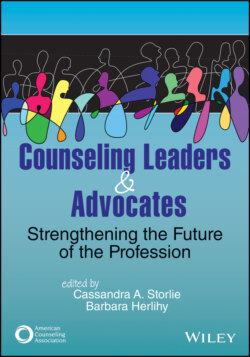Читать книгу Counseling Leaders and Advocates - Группа авторов - Страница 26
History of Multiculturalism in the Counseling Profession
ОглавлениеThe very roots of our counseling profession are multicultural in nature, beginning with Frank Parsons and his advocacy work in vocational guidance with the immigrant population (Zytowski, 2001). Culturally responsive practice has been woven into the fabric of the counseling profession throughout its development (Chung et al., 2011; Peters & Luke, 2021). However, active and intentional discrimination was also present during the inception of counseling as a profession.
In the civil rights era of the 1950s, systemic inequality and racism were common in the United States, and those prejudices permeated institutions and organizations (Morning & Sabbagh, 2005). People of color, particularly Black individuals, were twice blocked from developing a unique and separate division in the American Personnel and Guidance Association (APGA; AMCD, n.d.), which later became the American Association of Counseling and Development (AACD) and changed once again to become the American Counseling Association (ACA, n.d.). Discrimination was evident in counseling research as well, and BIPOC researchers had difficulty getting multicultural research published (Ratts & Pedersen, 2014). This prejudice in the counseling profession limited access to evidence-based, culturally sensitive, responsive counseling interventions for non-white populations. Instead, “clinical practices focused on assimilating culturally diverse clients into White culture” (p. 8).
As the 1960s began to unfold, societal turbulence in the United States led to changes in discriminatory policies such as those reflected in discrimination against BIPOC in counseling. It was during this time that counseling professionals began to push back against the monolithic approach to counseling and to recognize the various cultures that make up our society (Neukrug, 2016). Notably, a number of leaders and groups called attention to the problematic lack of representation of BIPOC among the ranks of leaders and the overall membership of the APGA (now ACA). Before 1972, the Association for Non-White Concerns in Personnel and Guidance, which would eventually become the Association for Multicultural Counseling and Development (AMCD), had limited representation in the APGA and had no voting rights on its board of directors or senate (AMCD, n.d.). This important group, in effect, demanded representation of BIPOC in the overall membership of APGA and throughout the counseling profession. As this multicultural paradigm shift gained traction and support in counseling, it was evident that culturally responsive and socially just values were cornerstones for the evolution and continued development of the profession (Ratts, 2009, 2011; Ratts & Pedersen, 2014). This multiculturalism movement set a precedent for attending to the needs of a variety of culturally and linguistically diverse clients, students, and communities. Simultaneously, this movement embedded humanistic thought, strengths-based practices, developmental approaches, and wellness models into counseling practice, education, and supervision (Vereen et al., 2014). Stemming from the growth and visibility of the AMCD in the counseling profession, the need for guiding documents to supplement codes of ethics included a drive to develop the first iteration of the Multicultural Counseling Competencies (MCC; Sue et al., 1992).
